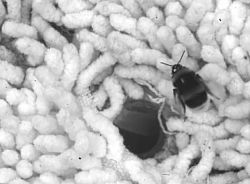Novice bumblebees stay close to home to learn the lie of the land, Sussex scientists find
Bumblebees leaving their nest for the first time learn the lie of the land by flying in ever-widening circles around their hive, Sussex scientists have observed.
 A bumblebee leaving the nest for the first time flies in ever-widening circuits of the nest entrance until it has learnt enough about its surroundings to find its way home
A bumblebee leaving the nest for the first time flies in ever-widening circuits of the nest entrance until it has learnt enough about its surroundings to find its way home
Professor Tom Collett, his Sussex colleagues Dr Olena Riabinina and Dr Andy Philippides, and Dr Natalie Hempel de Ibarra from the University of Exeter, found that the insects fly in tiny looping circuits that are centred on the nest, gradually broadening the survey until they have learned enough about their surroundings to guide themselves home at the end of their maiden flight.
Professor Collett, Emeritus Professor in Life Sciences, says: “Bumble bee nests are hidden in the undergrowth. The bees have to learn the exact relationship between objects that define the position of the nest and the nest hole.”
So instead of embarking on an epic journey and keeping their limbs crossed for a safe return home, the novices set about exploring the vicinity.
“One thing that they need to know is whether objects are near or far”, says Professor Collett.
Many insects use the speed that the image of an object travels across the retina of the eye to estimate their distance to an object: images of nearby objects move much faster than images of distant objects. Insects often simplify the task of estimating distance by making sure that their head does not rotate, compensating for any rotation of the body by moving the head in the opposite direction.
But bumblebees use a different strategy to estimate the distance separating two objects, such as the nest entrance and nearby foliage. They circle around the nest so that objects that are nearby move slowly across the eye, while more distant objects move faster.
The research team set up a bumblebee nest box, complete with a queen and several dozen workers, and then filmed the first tentative flights of new bees as they emerged from the nest. The insects initially strayed no more than a few centimetres from the nest entrance, but they eventually flew out of camera view 20–30 seconds later.
Then the team began the painstaking task of analysing how the learners moved their heads and bodies to find out whether they moved their heads to compensate for body rotations to stabilise the image as they circled around the nest. First, they measured the position of the bee's body in each frame of the movie as it circled the nest and then they meticulously measured the head movements by hand.
The team was surprised to see that instead of stabilising the image rotation completely by pivoting their head to counteract the body rotation, the learners' head movements under-compensated for the body rotations, allowing their heads to rotate slightly. This slight rotation causes images of objects close to the entrance of the nest to move slowly across the retina, while remote objects move faster, allowing the bees to distinguish between landmarks that were remote from the nest and those that would guide them home safely.
‘Head movements and the optic flow generated during the learning flights of bumblebees’ is published in the Journal of Experimental Biology today (Friday 1 August).
Watch the researchers’ short video showing how bumblebees use visual cues to find their nest entrance.
